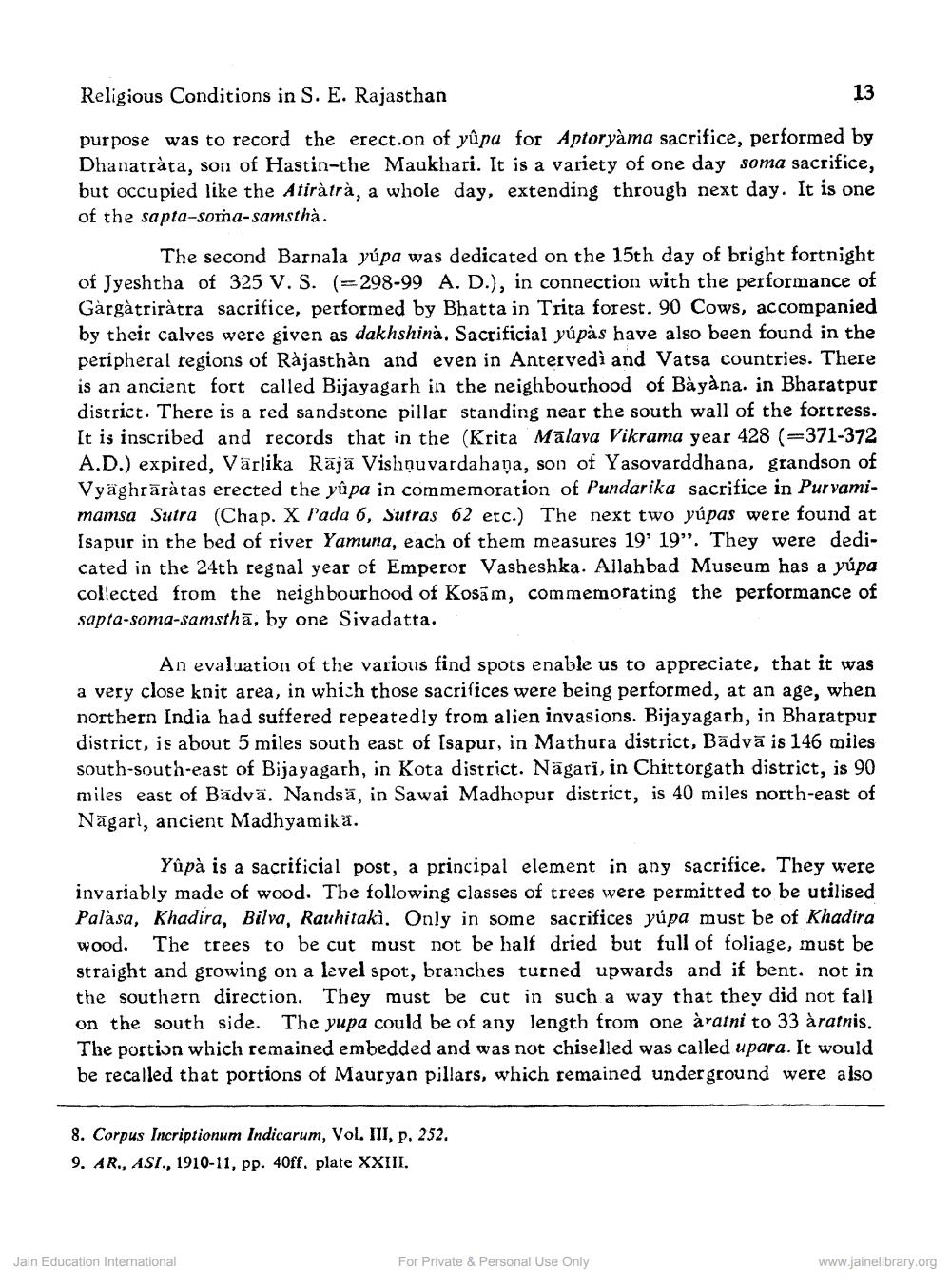Book Title: Religious Conditon in SE Rajasthan from early Inscriptions Author(s): Adris Banerji Publisher: Z_Jinvijay_Muni_Abhinandan_Granth_012033.pdf View full book textPage 3
________________ Religious Conditions in S. E. Rajasthan 13 purpose was to record the erect.on of yûpa for Aptoryama sacrifice, performed by Dhanatrata, son of Hastin-the Maukhari. It is a variety of one day soma sacrifice, but occupied like the Atiràtrà, a whole day, extending through next day. It is one of the sapta-soma-samsthà. The second Barnala yupa was dedicated on the 15th day of bright fortnight of Jyeshtha of 325 V.S. (=298-99 A. D.), in connection with the performance of Gargàtriràtra sacrifice, performed by Bhatta in Trita forest. 90 Cows, accompanied by their calves were given as dakhshina. Sacrificial yúpàs have also been found in the peripheral regions of Rajasthan and even in Antervedi and Vatsa countries. There is an ancient fort called Bijayagarh in the neighbourhood of Bàyána. in Bharatpur district. There is a red sandstone pillat standing near the south wall of the fortress. It is inscribed and records that in the (Krita Mālava Vikrama year 428 (=371-372 A.D.) expired, Värlika Rāja Vishņuvardahana, son of Yasovarddhana, grandson of Vyäghräratas erected the yûpa in commemoration of Pundarika sacrifice in Purvamimamsa Sutra (Chap. X Pada 6, Sutras 62 etc.) The next two yupas were found at Isapur in the bed of river Yamuna, each of them measures 19' 19". They were dedicated in the 24th regnal year of Emperor Vasheshka. Allahbad Museum has a yupa collected from the neighbourhood of Kosām, commemorating the performance of sapta-soma-samsthā, by one Sivadatta. An evaluation of the various find spots enable us to appreciate, that it was a very close knit area, in which those sacrifices were being performed, at an age, when northern India had suffered repeatedly from alien invasions. Bijayagarh, in Bharatpur district, is about 5 miles south east of Isapur, in Mathura district, Badvā is 146 miles south-south-east of Bijayagarh, in Kota district. Nägarī, in Chittorgath district, is 90 miles east of Bädvä. Nandsä, in Sawai Madhopur district, is 40 miles north-east of Nägari, ancient Madhyamikä. Yüpà is a sacrificial post, a principal element in any sacrifice. They were invariably made of wood. The following classes of trees were permitted to be utilised Palasa, Khadira, Bilva, Rauhitaki. Only in some sacrifices yúpa must be of Khadira wood. The trees to be cut must not be half dried but full of foliage, must be straight and growing on a level spot, branches turned upwards and if bent. not in the southern direction. They must be cut in such a way that they did not fall on the south side. The yupa could be of any length from one àratni to 33 áratnis. The portion which remained embedded and was not chiselled was called upara. It would be recalled that portions of Mauryan pillars, which remained under ground were also 8. Corpus Incriptionum Indicarum, Vol. III, p. 252. 9. AR., ASI., 1910-11, pp. 40ff. plate XXIII. Jain Education International For Private & Personal Use Only www.jainelibrary.orgPage Navigation
1 2 3 4 5 6 7 8 9
